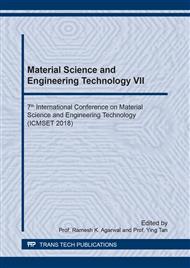p.3
p.10
p.15
p.24
p.32
p.38
p.44
p.50
Cavitation Erosion Behavior of Duplex Stainless Steel under High-Pressure Jet
Abstract:
Cavitation erosion (CE) behavior of 2205 duplex stainless steel (DSS) under high pressure was investigated by using water jet apparatus, which designed according to ASTM G134-95. The effects of the nozzle diameter and target distance on mass loss were analyzed. The CE behavior of 2205 DSS was evaluated by cumulative mass loss with time, and the incubation period and the CE rate were calculated by fitting results. From the scanning electron microscope (SEM) observation, it is found that the surface of 2205 DSS was damaged slightly during the CE incubation period and eroded dramatically in the accelaration stage. The energy dispersive spectrometer (EDS) results showed that the Ni content in the erosion area appeared obviously lower in comparison with the non-erosion area. Meanwhile, the content of Ni in ferrite was also detected to be clearly lower than in austenite with electron back scattered diffraction (EBSD) and EDS mapping techniques. Therefore, it could be concluded that CE take place selectively on the 2205 DSS surface, the damages were initiated and progressed in ferrite phase prior to in austenite phase.
Info:
Periodical:
Pages:
3-9
Citation:
Online since:
April 2019
Authors:
Price:
Сopyright:
© 2019 Trans Tech Publications Ltd. All Rights Reserved
Share:
Citation:


